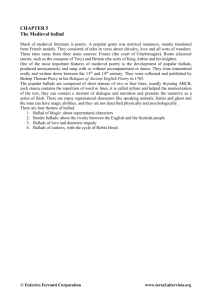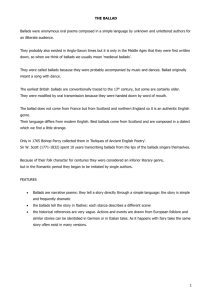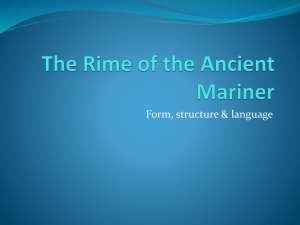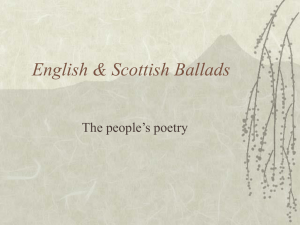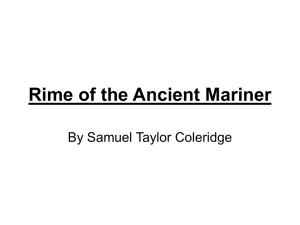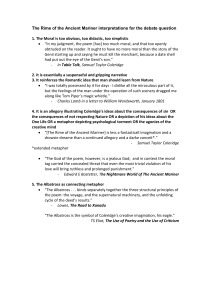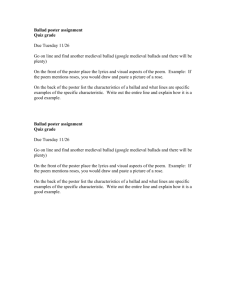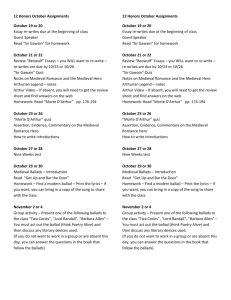Lyrical Ballads of Wordsworth and Coleridge
advertisement
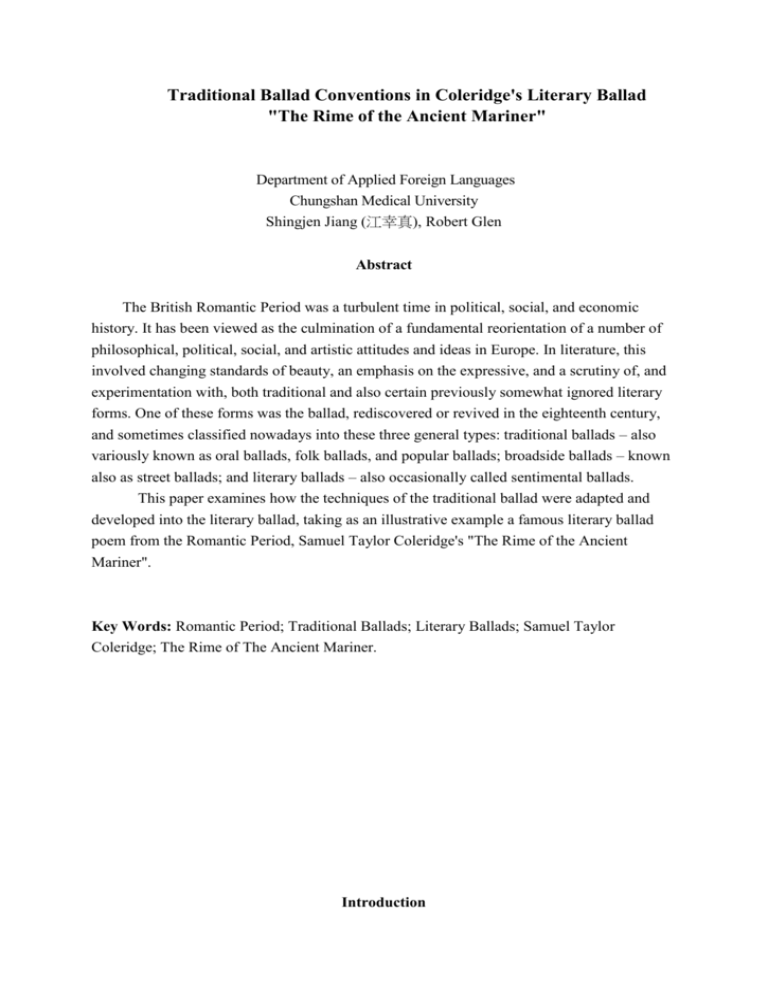
Traditional Ballad Conventions in Coleridge's Literary Ballad "The Rime of the Ancient Mariner" Department of Applied Foreign Languages Chungshan Medical University Shingjen Jiang (江幸真), Robert Glen Abstract The British Romantic Period was a turbulent time in political, social, and economic history. It has been viewed as the culmination of a fundamental reorientation of a number of philosophical, political, social, and artistic attitudes and ideas in Europe. In literature, this involved changing standards of beauty, an emphasis on the expressive, and a scrutiny of, and experimentation with, both traditional and also certain previously somewhat ignored literary forms. One of these forms was the ballad, rediscovered or revived in the eighteenth century, and sometimes classified nowadays into these three general types: traditional ballads – also variously known as oral ballads, folk ballads, and popular ballads; broadside ballads – known also as street ballads; and literary ballads – also occasionally called sentimental ballads. This paper examines how the techniques of the traditional ballad were adapted and developed into the literary ballad, taking as an illustrative example a famous literary ballad poem from the Romantic Period, Samuel Taylor Coleridge's "The Rime of the Ancient Mariner". Key Words: Romantic Period; Traditional Ballads; Literary Ballads; Samuel Taylor Coleridge; The Rime of The Ancient Mariner. Introduction The British Romantic Period, usually considered as dating from the year 1789 (the French Revolution) to about the year 1832, was a turbulent time in political, social, and economic history, influenced by several major historical events, such as the American Revolution, the French Revolution, the industrial revolution, and also by many important idea-based movements, such as the cultural/nationalism movement, and the antiquarian movement in Europe from about the 1740's onward. Accordingly, the Romantic Period has been viewed as the culmination of a fundamental reorientation of certain philosophical, political, social, and artistic attitudes and ideas in Europe in the last part of the eighteenth century. In its political and social aspects, it involved an examination and rethinking of traditional society and traditional forms of government, and a seeking of a golden age in the past. In literature, this reversal involved changing standards of beauty, an emphasis on the expressive, and a scrutiny of, and experimentation with, both traditional and some previously somewhat ignored literary forms. One of these forms was the ballad – "defined minimally as a stanzaic narrative poem or song" (Brown & Rosenberg 1998), rediscovered or revived in the eighteenth century, and sometimes classified nowadays into these three general types: traditional ballads – also variously known as oral ballads, folk ballads, and popular ballads; broadside ballads – known also as street ballads; and literary ballads – also occasionally called sentimental ballads (Laws 1972). Romanticists viewed humans in general as having an essentially good "primitive" subconscious nature, which they believed ought to be made more free and given expression to, and made less ridden over by the sometimes perverting dictates of excessive rational thought and reason. In keeping with those views, many people at that time looked back to medieval times for inspiration from what they considered a less complicated and more natural society and literature, as they sought the "natural bard," the "noble savage", "primitive" poetry, and "naive" perfection and sensibility/sentimentalism. Ballads provided Romanticists with a rich formal and conceptual model for the expression of their feelings and thoughts on various personal, social, political, and literary issues. Many Romanticists became attracted to and adapted the old ballads as a conceptual model into their works for ideological reasons. They expressed their political, social, and poetical notions and thoughts through the imitation or re-creation of the old ballads in their works. In this paper, a famous literary ballad from the Romantic Period, Coleridge's "The Rime of the Ancient Mariner", is examined to illustrate how traditional ballad characteristics were adapted into the literary ballad. Romanticism and the Literary Ballad Lyrical Ballads of Wordsworth and Coleridge Wordsworth and Coleridge developed a new type of poetry in Lyrical Ballads. It was published in 1789, and is not only a mark of the beginning of the Romantic Period, but also of a revolution in literary taste and sensibility. "The Preface to the Lyrical Ballads" (1800), written by Wordsworth, is probably the single most important critical document in the history of the English Romantic Period. In it, Wordsworth explained why the poems in Lyrical Ballads were "so materially different" from the customary or neoclassical conceptions of poetics: the poems in Lyrical Ballads were written in the "real language of men," the incidents related in them were selected from "common life;" and the figures of speech used in them arose from the passions in "the very language of men." Wordsworth's view that passions are articulated most plainly in the unmannered language of rustic life can be compared to and seen as perhaps having been influenced by Rousseau's view that such language is a more "permanent" and "philosophical" language. In his The Ballad of Tradition (1932), Gordon H. Gerould viewed William Wordsworth as having been affected mainly by broadside ballads (written assimilations and adaptations of traditional oral ballads, particularly used in urban contexts for religious, political, and other non-purely literary purposes) and Samuel Taylor Coleridge as owing more to traditional, original-type ballads (i.e., orally transmitted folk ballads). That view of Coleridge's writing is shared by others as well, for example, Hodgart (1962): "The Rime of the Ancient Mariner was professedly written in imitation of the style as well as the spirit of the elder poets, and Coleridge has taken over and transmuted the rhythm, diction, and atmosphere of the best supernatural ballads" (P. 149). Coleridge's "The Rime of the Ancient Mariner" (1798) Lyrical Ballads includes Coleridge's famous poems, "The Rime of the Ancient Mariner", "The False Mother," and "The Nightingale." Although Coleridge did not actually write very many ballads, he played an important and significant role in the history and the development of literary ballads. Among the poems that he modeled after traditional ballads, "The Rime of the Ancient Mariner" is one of the most renowned, and in fact is perhaps the most famous literary ballad in the English language. It can well serve as an example of how Coleridge adapted several techniques of traditional ballads to create his literary ballads. The poem is a narrative of a medieval ship voyage and its aftermath, involving the supernatural punishment and penance of a seaman who carelessly but heartlessly shot an albatross, which had been taken as a bird of good omen and temporary mascot of sorts by the crew of his ship, in the Antarctic regions. Part of the mariner's penance is to wear the dead albatross around his neck, which he is not set free from until he somewhat unthinkingly has a sudden feeling of love towards and wishes a blessing on some water snakes he sees. The other part of his penance involves him having a continuing periodic compulsion to wander about and then tell his tale to someone he sees that he somehow suddenly knows or feels is the person he has to tell it to. In the poem, the mariner, who is the narrator, accosts and tells his story to a man who passes him on the way to a wedding. The man is impatient to get away and go to the wedding but is captured first by the mariner's grasp and then by his gaze and listens anyway. At the end of the mariner's tale, the man turns and goes away from the wedding "like one that hath been stunned", and awakes the next day "a sadder and a wiser man." Coleridge had never been to sea at the time of the poem's composition, but having read widely was still able to plausibly write of a sea voyage to the Antarctic and back. His readings also influenced other aspects of the poem. "The Wandering Jew", an old broadside ballad in "Reliques," and Percy's (1765) notes to the ballads, probably played a large role in shaping Coleridge's conception of the old navigator for the poem, although the contributions of Schiller's "Der Geistseher," "Monk Lewis", and the old salt in "Sir Patrick Spense" have been argued to be more significant (Friedman 1961). Coleridge adapted and modified the traditional tale of the Jewish tradesman who refused Jesus a pause for rest and was condemned to life in death continuously recounting his sin, until Jesus's second coming. The ancient mariner must undertake a similar penance for his careless, unloving attitude towards and killing of the albatross, just a bird to the mariner then, but one of "all things both great and small" which the poem at the end advises the reader to love without distinction. Conventions of the Traditional Ballad Form Modified and Adapted in "The Rime of the Ancient Mariner" In "The Rime of the Ancient Mariner", Coleridge modified and incorporated a number of the mechanics and other conventions of the ballad form. Like traditional ballads, it has four-line ballad stanzas (although occasionally also two and six-line stanzas) which are made up of short lines and which employ a simple meter (alternating tetrameter and trimeter) and a simple rhyme scheme (abab), which produces a songlike quality – a quality common in traditional ballads. The main part of the poem is a combination of narration and dialogue style, with largely unassigned speeches, all of which is common in traditional ballads. These traditional ballad-like elements are all illustrated in the poem's opening stanza. It is an ancient Mariner And he stoppeth one of three. – "By thy long gray beard and glittering eye, Now wherefore stopp'st thou me? Traditional ballads involve some incremental repetition of words and lines in different stanzas in the course of a ballad. Although Coleridge's literary ballad does not involve that sort of repetition, it does involves a certain amount of repetition of words and lines, such as can be seen in the following two (non-contiguous) stanzas. The ice was here, the ice was there, The ice was all around: It cracked and growled, and roared and howled, Like noises in a swound! Water, water, everywhere, And all the boards did shrink; Water, water, everywhere, Nor any drop to drink. The poem's themes involve sin, love, and redemption, which are common to much folklore, including traditional ballads, and the themes are explored in the poem in a relatively objective manner, as is common in ballads. The main narrator, the Ancient Mariner, simply relates what happened to him more or less as if he had just been an observer and does not philosophize about it. Supernatural elements, such as the curses or spells in this poem, are also likely elements in fabulous tales and legends, which are common material for traditional ballads. The following stanza, for example, contains the themes of sin and redemption (at least partial redemption), and a curse, with the Ancient Mariner's narration made in a fairly flat and objective way. The selfsame moment I could pray; And from my neck so free The Albatross fell off, and sank Like lead into the sea. Traditional ballads typically involve a limited number of characters, in a narrative, and have an emphasis on relationships and conflicts. In "The Rime of the Ancient Mariner," the narrative focus is on a single event, or action, and the resulting experiences of a sailor on a sea voyage, with an emphasis on the conflict that results from the Mariner's killing of the albatross. Like narratives in traditional ballads, the poem's narrative utilizes dramatic tension. The narrated tale of the Mariner involves considerable dramatic tension, as he and the other seamen on the ship meet many difficulties and dangers on the voyage, and he alone barely survives to make it back home. In addition, there is a more subtle but just as dramatic a tension in the relationship between the Mariner and his current listener, the wedding guest. At the beginning of the poem, the listener, although powerless to escape, seems to consider himself to otherwise be above or superior to the Mariner. At the end of the poem, however, the listener seems reduced in his own estimation to a level less superior than before to that of the Mariner, as the closing stanza of the poem suggests. He went like one that hath been stunned, And is of sense forlorn: A sadder and a wiser man, He rose the morrow morn. Finally, like many ballads, the Rime ends with an explicit moral, in the third- and fourth-to-last stanzas: He prayeth well, who loveth well Both man and bird and beast. He prayeth best, who loveth best All things both great and small; For the dear God who loveth us, He made and loveth all. Conclusion Ballads, often classified nowadays as traditional oral ballads, broadside ballads, and literary ballads, have had an enormous influence on English literary poetry, and were especially important in the development of Romanticism in the late eighteenth century. The literary ballads of the Romantic Period arose out the Romanticists' strong appreciation for traditional oral ballads and broadside ballads, which they took as inspiration and source for a conceptual and formal model to articulate their feelings, ideas, and ideologies in the political, social, and economical turmoil of the times. Many important historical events and conceptual movements occurred or developed along with Romanticism in the eighteenth century, among them the American and French revolutions, the industrial revolution, the development of cheap printing, the cultural/nationalism movement, and the antiquarian movement. These events and movements significantly influenced the ideologies and thinking of the people, inducing a shift of the public taste in literature in the late eighteenth and nineteenth centuries toward realistic, exotic, mysterious, relatively unsophisticated, but more overtly emotional literary expressions of the past, and inter-relatedly and interactively inspiring the Romanticists' fascination with and interest in adapting the traditional ballad into their works – thus stimulating the birth of the literary ballad in British Romantic literature. In the era of the wars, revolutions, and ideological movements of the second half of the eighteenth century, most Romanticists expressed their political, social, and poetical notions and thoughts through the imitation or re-creation of the old ballads in their works. Among them, Coleridge played an important and significant role in the history and the creation of literary ballads. Among the great number of poems that have been modeled after the traditional ballad, "The Rime of the Ancient Mariner" is probably the most famous to people in general, and is considered by scholars to be one of the best, if not the best, literary ballad in the English language. In "The Rime of the Ancient Mariner", Coleridge modified and adapted several techniques of the ballad form. For example, it is a narrative poem employing many aspects of traditional ballad conventions, such as a combination of narration and dialogue style, mainly four-line ballad stanzas, simple prosody, unassigned speeches, word and line repetition, and a limited number of characters. The narrative focuses on a single event - an experience of a sailor at sea; engages relationships and conflicts between characters, effects a building up of the attraction or interest of the poem; has an element of dramatic tension in the story; involves the themes of sin, love, and redemption, maintains a relatively objective perspective, and employs supernatural elements, such as curses and spells. Although some critics have at times questioned the authenticity and creativity of literary ballads concerning their imitation of old ballads, the literary ballads of the Romantic Period have their own special artistry, and can be seen to play an important role in the history of British literature. References Brown, Mary Ellen and Rosenberg, Bruce A. (1998) (eds.). Encyclopedia of Folklore and Literature. Santa Barbara, CA: ABC-CLIO. Coleridge, Samuel Taylor (1975). The Complete Poetical Works of Samuel Taylor Coleridge. Oxford: The Clarendon press. Friedman, Albert B (1961). Ballad Revival: Studies in the Influence of Popular on Sophisticated Poetry. The University of Chicago Press. Gerould, Gordon Hall (1974). The Ballad of Tradition. New York, Gordian Press. Herder, Johann Gottfried von (1967-1968). Sammtliche Werke. Ed. Bernhard Suphan. 3 Volumes. Hildesheim, Germany: George Olms. Hodgart, M. J. C. (1962). The Ballads. 2nd Ed. London: Hutchinson University Library. Laws, G. Malcolm, Jr. (1972). The British Literary Ballad. USA: Southern Illinois University Press. Percy, Thomas (1765). Reliques of Ancient English Poetry: Consisting of Old Heroic Ballads, Songs, and Other Pieces of Our Earlier Poets Together with Some Few of Later Date. 3 Volumes. London: Dodlsey. Wordsworth, William (1950). The Complete Poetical Works of William Wordsworth. London: Macmillan. Wordsworth, William and Coleridge, Samuel Taylor (1995). Lyrical Ballads, W. J. B. Owen (ed.). Oxford University Press.
